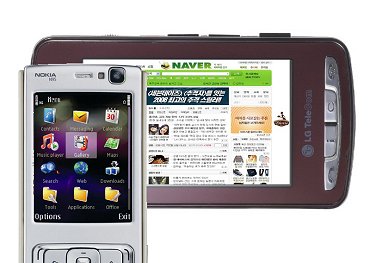Two things got me thinking this week. First there was the last AAS Insight podcast, looking at smartphone form factors (among other things), then there was Russell Beattie declaring his love for middle gadgets ('midgets', somewhat misleadingly!). You see, I do like to keep the mobile world neatly classified in my head and the appearance of the likes of the Nokia N810, the HTC Shift and Advantage, and the LG pictured in Russell's piece all 'break' something in my head.
You see, they're all either too big, or verging on being too big.
Now, I know what you're going to say - "But Steve, what about that Nokia E90 that you're partial to?". The thing is, the clamshell E90, when closed, is still phone-sized. A phone that really needs to go on a diet, but a phone nevertheless. The E90 is a masterpiece example of design, in how to get the maximum screen and keyboard real estate into as small a device as possible.
 But I see geeks across the world loving, I mean absolutely loving the likes of the Nokia N810 and HTC uber-devices. And why not? They're superb bits of kit for the technophile and they really can replace many other gadgets when used properly. But the problem is... that these large-screened 'midgets' are ONLY desired by geeks, those for whom the technology is as important as other aspects of their life - and I speak as a geek myself, but as one who lives surrounded by hundreds of non-geeks/normobs/whatever-you'd-like-to-call-them.
But I see geeks across the world loving, I mean absolutely loving the likes of the Nokia N810 and HTC uber-devices. And why not? They're superb bits of kit for the technophile and they really can replace many other gadgets when used properly. But the problem is... that these large-screened 'midgets' are ONLY desired by geeks, those for whom the technology is as important as other aspects of their life - and I speak as a geek myself, but as one who lives surrounded by hundreds of non-geeks/normobs/whatever-you'd-like-to-call-them.
So I don't dismiss 'middle gadgets' out of malice or any particular dislike, it's simply that I want to see smartphones and smart technology generally get into the mainstream. One of the reasons I rate the Nokia N95 (and soon the N82 and, I suspect, the N78) so highly is because they'll be bought in High Street shops on next-to-nothing contracts in their millions. So while 'midgets' sell in their tens of thousands per month to early adopter geeks, the Nseries S60-powered smartphones sell well over a million each week.
Living life in the mainstream means that a 'smart mobile device' (the term used by Canalys) must fit easily into a pocket and must not weigh appreciably more than a traditional dumb-phone. This size factor is absolutely crucial - if you don't feel you can take it with you down the pub or on a walk or into town to go shopping, then it's too big and merely identifies the owner as a gadget lover rather than [cue emotive music, swelling strings, etc.] a true follower of 'the smartphone lifestyle'. And if size isn't enough of a factor, a smart mobile device must be affordable and be robust enough to be dropped onto the pavement once a month and carry on working. That's a tall, tall order for a wide-screened, touch-sensitive tablet.
So excuse me if I don't join in the love-fest for Internet tablets/midgets across the tech blogs on the Internet. They'll never break through into being household names. They'll not be lusted after by bright teenagers across the planet. They'll not be picked up by operators and pushed through hundreds of thousands of high street shops across the world. In contrast, walk through any city in the world today and count the number of Nokia S60 smartphones you see in people's hands. I think you'll be surprised.
So, apparently, the messages in my daily spam filter are right - size IS everything.
8-)
Steve Litchfield, All About Symbian, 21st March 2008
PS. Happy Easter!
